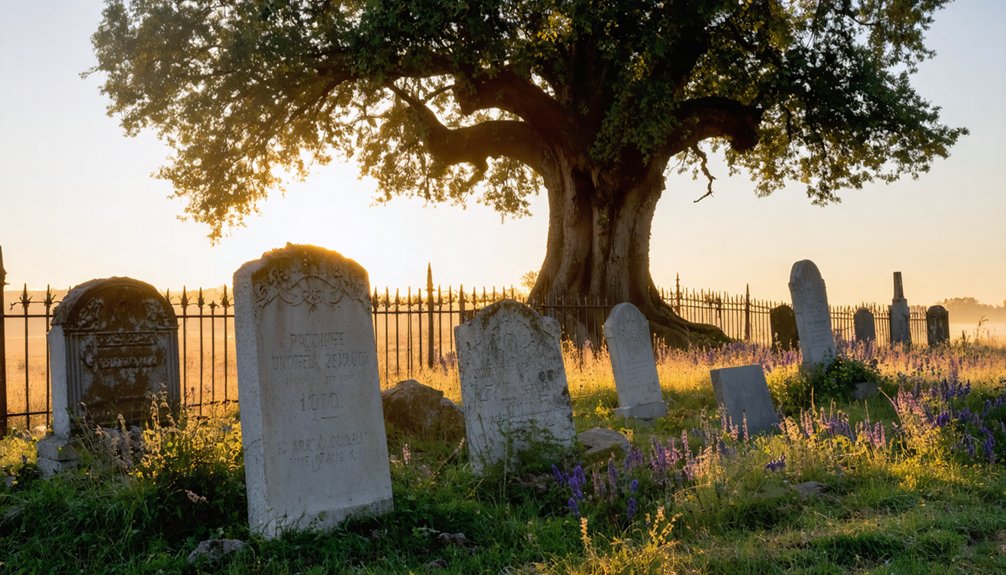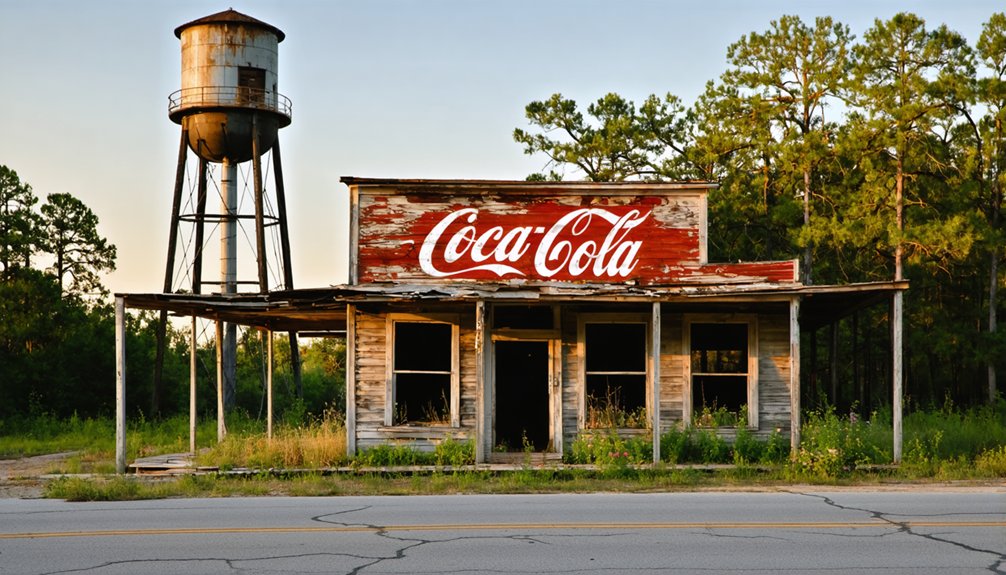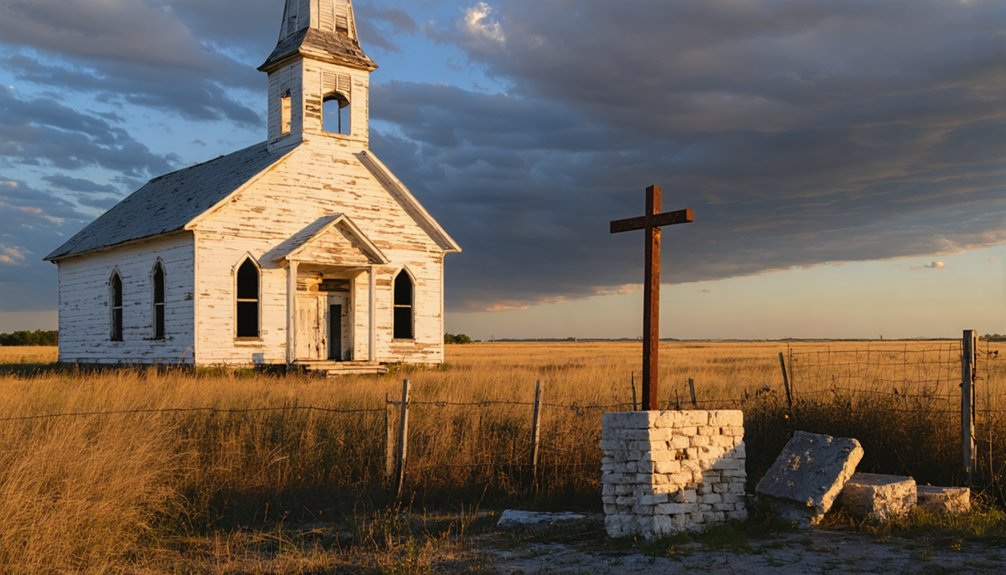You’ll find Owensville’s remains five miles northwest of Franklin, Texas, along FM Road 46. This former Robertson County seat thrived from 1855 to 1870, boasting an academy and courthouse until an 1868 railroad bypass sealed its fate. While the town has vanished, its historic cemetery endures as the county’s oldest burial ground, where a recently removed fence tells a complex story of segregation, reconciliation, and local resilience spanning nearly 150 years.
Key Takeaways
- Owensville was Robertson County’s third county seat from 1855-1870, featuring an academy and post office before becoming a ghost town.
- The town’s decline began when the Houston & Texas Central Railway bypassed it in 1868, causing businesses and residents to relocate.
- A devastating yellow fever epidemic in 1872-1873 further accelerated the town’s abandonment.
- Only the historic Owensville Cemetery remains today, located five miles northwest of Franklin along Farm to Market Road 46.
- The loss of county records and relocation of the county seat to Calvert in 1870 sealed Owensville’s fate as a ghost town.
Early Settlement and County Seat Years
Though it began as a strategic location along the Houston-Waco transportation route, Owensville emerged as Robertson County’s third county seat between 1855 and 1869 after D. H. Love donated the land for its establishment.
Owensville’s rise to county seat status marked a pivotal transition from frontier stopover to thriving administrative hub in Robertson County.
The settlement patterns reflected the era’s frontier development, with the town attractively positioned along major mail, stage, and freighting corridors. Similar to how William Owens’ store helped establish early commerce in another Owensville, this town’s strategic position fostered economic growth.
You’ll find that the community dynamics were shaped by Harrison Owen, the county’s first clerk and the town’s namesake.
The cotton-based plantation economy flourished during Owensville’s peak years as county seat, with production increasing dramatically through the 1850s.
As the seat of county government, Owensville drew an influential mix of public officials, doctors, lawyers, and merchants.
The town’s development included boarding houses and businesses, while the establishment of a post office signaled its growing administrative importance.
These elements combined to create a vibrant civic center that served both travelers and residents alike.
Rise and Fall During the Civil War Era
Owensville’s prominence as Robertson County’s seat took on heightened significance during the Civil War years. You’ll find that the town served as an essential hub for mustering Confederate troops while its courthouse managed the estates of fallen soldiers and handled mounting political tensions between divided loyalties.
The historic cemetery grounds reflect the deep racial divisions of the era, with a fence separating white and black burial sections. As the conflict intensified, you’d have witnessed the community straining under the weight of wartime demands. Local units organized for Confederate service while the economy struggled with reduced agricultural labor and resource shortages. The courthouse experienced a surge in activity as officials worked to manage and distribute arms for defense throughout the region.
The Great Railroad Bypass Impact
You’ll find the 1868 Houston & Texas Central Railway’s decision to bypass Owensville marked the town’s fatal turning point, as merchants and professionals quickly relocated to the newly established railroad town of Calvert.
The economic ripple effects were immediate and severe, with businesses shuttering and residents departing for rail-connected communities that offered better commercial prospects. Only the historic Owensville Cemetery remained as a lasting testament to the once-thriving community, formally established in 1869 through John B. Glap’s land deed. The town had previously prospered as a stop on the Houston-Waco road, serving mail, stage, and freight traffic.
When the county records moved to Calvert in 1869-1870, Owensville lost both its county seat status and its last chance at economic survival, sealing its destiny as a future ghost town.
Economic Ripple Effects
When the Houston & Texas Central Railway bypassed Owensville in 1868, it triggered a devastating chain of economic events that would ultimately transform the once-thriving county seat into a ghost town.
You’ll find that the economic migration hit Owensville hard and fast. Merchants, lawyers, doctors, and public officials quickly relocated to the newly platted town of Calvert, which had secured the coveted railroad stop.
The commercial decline was severe as businesses shuttered and trade opportunities vanished. Without rail access, Owensville’s transportation costs soared, making it impossible to compete with rail-connected towns. The slow pace of oxen-drawn wagon transport made shipping goods increasingly impractical and expensive. The post office closure in 1872 further isolated the community from vital communication networks.
The loss of county seat status to Calvert dealt another blow, as government offices and associated services departed. The town’s isolation from new transportation networks sealed its fate, leading to its eventual abandonment.
Fatal Transportation Decision
Despite its strategic location on the Houston-Waco route, Owensville faced a pivotal moment in 1868 as the Houston & Texas Central Railway charted its course through Robertson County.
The railroad’s decision to bypass the town proved catastrophic for the community’s survival. While stage routes had once made Owensville a thriving hub, the new transportation infrastructure demanded different priorities – direct paths between major population centers that would maximize revenue.
You’ll find that this fatal decision triggered an immediate exodus. The county seat shifted to rail-connected Calvert, taking with it the government offices, professionals, and businesses that had sustained Owensville’s economy.
Without the railroad’s lifeline, the town’s community resilience crumbled. What was once a bustling center of trade and governance quickly faded into little more than a historical marker and cemetery. Today, visitors can still explore the rich history through Texas Escapes preservation efforts.
Legacy of Harrison Owen and Local Leaders
Through his pivotal role as Robertson County’s first clerk from 1838 to 1847, Harrison Owen left an indelible mark on Owensville’s development and early Texas governance. His foundational work in establishing local administrative structures helped position Owensville as a thriving political center, eventually leading to its selection as the county’s third seat in 1855.
You’ll find Owen’s legacy woven throughout the fabric of local leadership that followed. D.H. Love’s land contribution enabled the town’s growth, while dedicated judges, lawyers, and doctors sustained Owensville’s prominence as an administrative hub. The courthouse square became the center of community life and local commerce.
During the Civil War, these leaders organized military support and civilian care, demonstrating remarkable resilience. Though Owensville’s prominence faded after 1870, historical markers and the county’s oldest cemetery still stand as evidence to Owen’s contributions and the impact of local governance.
Owensville Cemetery Through Time

As one of Robertson County’s oldest burial grounds, Owensville Cemetery stands as a tribute to more than 180 years of local history.
You’ll find its origins dating back to 1837, though it wasn’t officially established until 1869 when John B. Glap deeded the land for cemetery use.
The cemetery’s historical preservation reflects both triumph and struggle, with a 412.87-foot fence once dividing White and Black burial sections – a physical reminder of segregation that stood until 2024.
A stark metal barrier once split this sacred ground, marking a shameful era of segregation in death as in life.
Today, the site serves as a crucial cultural heritage landmark, documenting the area’s complex past through its headstones and family plots.
While the town of Owensville has vanished, its cemetery endures as one of the few remaining symbols of the community’s existence, now welcoming all residents regardless of race.
Stories Behind the Segregated Burial Grounds
While residents of Owensville lie in eternal rest, the cemetery’s 412.87-foot fence stood for nearly 150 years as a stark reminder of racial segregation‘s reach beyond life itself.
You’ll find segregated narratives etched into the very ground, with White burials confined to the east and Black burials to the west, reflecting deeply rooted social divisions that persisted from the mid-19th through mid-20th centuries.
The burial traditions in Owensville Cemetery West speak to the resilience of the African-American community, whose stories are now preserved through the dedicated work of the West Association.
In 2024, you witnessed a powerful moment of reconciliation as community members finally removed the dividing fence, marking a significant step toward healing the wounds of the past.
Geographic Significance and Local Landmarks

When Robertson County commissioners sought their ideal county seat in the mid-1800s, they selected Owensville‘s location at the geographic center of the county. The site, situated on David Love’s donated land, lay five miles northwest of present-day Franklin and served as a vital crossroads between Morgan and Sterling.
You’ll find Owensville’s geographic importance reflected in its strategic placement along Farm to Market Road 46, though today it stands as a ghost town with few remnants of its past glory.
While the original courthouse and most structures have vanished, two significant landmarks preserve local history: the Owensville Cemetery East and its African American counterpart, Owensville West Cemetery.
These burial grounds, along with historical markers, remain the primary physical evidence of this once-essential administrative center’s existence.
From Thriving Hub to Abandoned Settlement
During its peak years from 1855 to 1870, Owensville thrived as Robertson County’s third county seat, boasting the region’s only academy and a bustling post office established in 1856.
The community dynamics shifted dramatically after the Civil War when railroads bypassed the town, and a devastating yellow fever epidemic struck in 1872-1873. The final blow came when county judge I.B. Ellison moved the county seat to Calvert in 1870, taking with it the town’s administrative importance and essential records.
You’ll find that Owensville’s transformation into a ghost town happened swiftly. The post office’s closure in 1872 marked the settlement’s rapid decline, though it briefly reopened from 1895-1897.
Today, only the historic cemetery remains as a reflection of this once-thriving frontier community.
Preserving Owensville’s Historical Memory

Today you’ll find Owensville’s legacy most prominently preserved in its historic cemetery, which stands as the oldest and largest burial ground in Robertson County.
You can explore the community’s lost stories through resources like the Robertson County Historical Survey Committee’s publications and the Texas State Historical Association’s detailed records.
The Texas Historical Markers at the site serve as permanent indicators to Owensville’s significance as a former county seat and Confederate Army provisioning point during the Civil War.
Cemetery’s Sacred Ground Today
As one of Robertson County’s oldest burial grounds, Owensville Cemetery stands as a powerful tribute to over 200 years of Texas history and cultural heritage.
You’ll find this sacred space transformed through cemetery preservation efforts and racial reconciliation, with the removal of segregating barriers that once divided the grounds.
- The cemetery association actively maintains and documents the historic graves
- Community events and educational programs connect visitors with local heritage
- Former racial divisions have given way to unified grounds honoring all ancestors
- Historical markers and interpretive signs tell the story of Owensville’s past
- The site serves as an essential link to the vanished town’s diverse community
Today, this Historic Texas Cemetery continues to bring together descendants and history enthusiasts, preserving the legacy of both prominent settlers and formerly enslaved individuals who shaped Robertson County.
Documenting Lost Community Stories
The painstaking work of preserving Owensville’s historical memory extends far beyond the cemetery’s physical boundaries.
You’ll find that reconstructing daily life in this vanished Texas town poses unique challenges, as few physical structures remain to tell the tale. Local historians rely heavily on oral histories passed down through generations, cemetery records, and historical markers to piece together the community’s rich narrative.
The story that emerges is one of remarkable community resilience – from Owensville’s early days as a county seat through its role in the Civil War and its eventual decline.
While written documentation may be sparse, the combined efforts of academics, preservation groups, and descendants help maintain these essential connections to the past, ensuring that Owensville’s legacy lives on despite its ghost town status.
Historical Marker Significance
Standing proudly at the junction of FM 979 and FM 46, Owensville’s Texas Historical Marker #10936 serves as an important tribute to the town’s significant role in Robertson County’s development.
Dedicated in 1974 by Mary Katherine Thompson Galloway, the marker preserves essential details about this once-thriving community‘s historical significance and community engagement during pivotal moments in Texas history.
The marker highlights several key aspects of Owensville’s legacy:
- Its status as Robertson County’s third county seat from 1855 to 1869
- The town’s critical role during the Civil War in supporting soldiers and civilians
- Its position along the important Houston-Waco transportation route
- Recognition of Harrison Owen, the county’s first clerk
- The historical connection to Owensville Cemetery, the county’s oldest burial ground
Frequently Asked Questions
What Did the Original County Courthouse in Owensville Look Like?
You’d find a wooden, two-story courthouse measuring 40 feet square, supported by oak block foundations and featuring exterior stairs. This historically significant architecture matched local courthouse designs of 1855.
Were There Any Schools or Churches Established in Owensville?
Like a beacon of learning, you’d find Owensville’s academy standing proud as the county’s only formal school in the 1850s-1870s, though church services likely occurred without dedicated buildings.
What Businesses Operated in Owensville During Its Peak Years?
While you’ll find references to general stores and possibly blacksmith shops, there’s no concrete documentation of specific businesses. Records only mention “stores” that later relocated when the county seat moved.
How Many People Lived in Owensville at Its Largest Population?
Like many frontier towns of its era, you won’t find exact Owensville demographics recorded. While historical records confirm it was a bustling county seat, the precise peak population remains unknown.
Are There Any Remaining Original Structures or Foundations Visible Today?
You won’t find any original abandoned buildings standing today. The only visible historical remnants are the cemetery and a 1974 Texas historical marker indicating where this once-thriving settlement existed.
References
- https://www.kxxv.com/news/local-news/in-your-neighborhood/overcoming-segregation-owensville-cemetery-honors-its-past-and-its-future
- http://www.countygenweb.com/txrobertson/books/GhostTownsOwensville.htm
- https://www.findagrave.com/cemetery/2320549/owensville-west-cemetery
- https://en.wikipedia.org/wiki/Owensville
- http://www.countygenweb.com/txrobertson/books/ghostlyhauntscollection.htm
- https://en.wikipedia.org/wiki/List_of_ghost_towns_in_Texas
- https://texashistory.unt.edu/ark:/67531/metapth61101/m1/170/
- https://www.texasescapes.com/WestTexasTowns/Owenville-Texas.htm
- https://www.texasescapes.com/CentralTexasTownsSouth/Owensville-Texas.htm
- https://www.tshaonline.org/handbook/entries/owensville-tx



